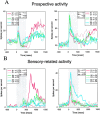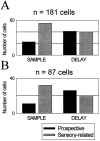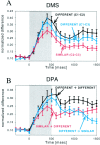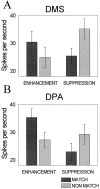Prospective coding for objects in primate prefrontal cortex
- PMID: 10377358
- PMCID: PMC6782318
- DOI: 10.1523/JNEUROSCI.19-13-05493.1999
Prospective coding for objects in primate prefrontal cortex
Abstract
We examined neural activity in prefrontal (PF) cortex of monkeys performing a delayed paired associate task. Monkeys were cued with a sample object. Then, after a delay, a test object was presented. If the test object was the object associated with the sample during training (i.e., its target), they had to release a lever. Monkeys could bridge the delay by remembering the sample (a sensory-related code) and/or thinking ahead to the expected target (a prospective code). Examination of the monkeys' behavior suggested that they were relying on a prospective code. During and shortly after sample presentation, neural activity in the lateral PF cortex primarily reflected the sample. Toward the end of the delay, however, PF activity began to reflect the anticipated target, which indicated a prospective code. These results provide further confirmation that PF cortex does not simply buffer incoming visual inputs, but instead selectively processes information relevant to current behavioral demands, even when this information must be recalled from long-term memory.
Figures










References
-
- Asaad WF, Rainer G, Miller EK. Neural activity in the primate prefrontal cortex during associative learning. Neuron. 1998;21:1399–1407. - PubMed
-
- Barbas H. Anatomic organization of basoventral and mediodorsal visual recipient prefrontal regions in the rhesus monkey. J Comp Neurol. 1988;276:313–342. - PubMed
-
- Colombo M, Graziano MS. Effects of auditory and visual interference on auditory-visual delayed matching to sample in monkeys (Maca fascicularis). Behav Neurosci. 1994;108:636–639. - PubMed
-
- Constantinidis C, Steinmetz MA. Neuronal activity in posterior parietal area 7a during the delay periods of a spatial memory task. J Neurophysiol. 1996;76:1352–1355. - PubMed
Publication types
MeSH terms
LinkOut - more resources
Full Text Sources
Other Literature Sources
